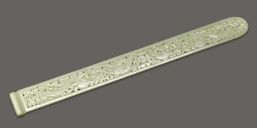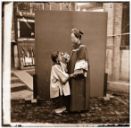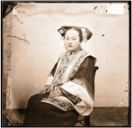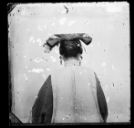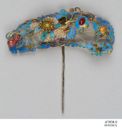The coiffure
...and wearing the same kind of headdress with flowers on each side made of pearls and jade, a pearl tassel on the left side and a beautiful phoenix in the center made of purest jade.[Cf, p 18-19]
When you think of hairstyles during the Qing dynasty, you’ll probably think of those tall detachable headdresses made of satin. This is not surprising since that is the way many Chinese period dramas portray the hairstyles of women during the Qing dynasty. However, those tall headdresses were not worn until Cixi and her court ladies started to wear them regularly.[Cf, p 168.]
Married Manchu women wore the yizitou 一字頭 version of the liangbatou 兩把頭 hairstyle. Then it started to evolve into an exaggerated headpiece of the liangbatou. This consisted of a wire frame with a bianfang 扁方 and two barbel-like ornaments on either sides. With this version it was still required to use one’s own hair to wrap around the frame. The advantage of this hairdo is that there is more room for hair ornaments. [Cf, p 176-177] The following passage by the early photographer John Thomson describes the way the hairstyle is put together.
The basis of the device consists of a flat strip of wood, ivory, or precious metal about a foot in length. Half of the real hair of the wearer is gathered up and twisted in broad bands round this support, which is then laid across the back of the head … careful study of the illustrations will, I doubt not, reward any lady who may desire to dress her hair ‘à la Manchu. [Cf, volume 4, 28]
As Cixi became older, her hair wasn’t thick enough to create the usual liangbatou. In the first decade of the twentieth century the dalachi 大拉翅 was born. This was made of the same frame as the previous hairdo with the only difference being that the hair is replaced by black satin. Over the years this headpiece became wider and taller, indicating one’s status. [Cf, p 175-177]
The headpiece is then adorned with fresh flowers, hairpins and other ornaments. Usually the hairpins and other accessories, if they are being worn by someone of nobility, are inlaid with kingfisher’s feathers. This style of Chinese art is called diancui 點翠. The earliest record of this art was found in the Han dynasty while physical examples of these accessories mostly date from the Qing dynasty, since the feathers easily decompose in certain environmental conditions. This art practice ended at the beginning of the Republic era as a means to conserve the kingfisher species. Craftsman, however, continued to try to recreate the blue hue with enamel.
Even though the dalachi has no use in this day and age, it still remains a gorgeous headpiece to look at.
